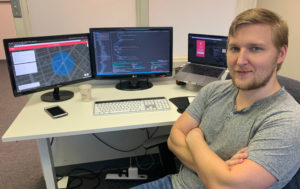Innovate
Callyo introduces i911, a game-changer for emergency services

Our nation’s 911 emergency call system isn’t perfect – in many communities, the call centers are understaffed and burdened with outdated infrastructure. And out of approximately 200 million 911 calls made in the U.S. every year, 80 percent of them are made from cell phones.
This can cause serious, often deadly, issues. For all of its many benefits – thousands of lives are saved every year – the American emergency response system is only equipped to triangulate the coordinates of someone calling from a land line.
In December 2014, Shanell Anderson’s SUV rolled into a suburban Atlanta retention pond while she was delivering newspapers early in the morning. From her cell phone, she calmly told 911 where she was, down to the nearest intersection, but the dispatcher was unable to pinpoint the exact location. Anderson, 31, drowned.
“I got sick and tired of seeing articles about people who were not located in time, because the location came back poorly,” says Chris Bennett, the founder of Callyo, the St. Petersburg-based company that develops innovative mobile technology for law enforcement.
Sometimes, Bennett adds, “we just see problems sitting out there, and it frustrates us to say ‘How has nobody solved this problem yet? We know how to solve it, and it can make a big impact immediately.”

Callyo founder Chris Bennett. Photo by Bill DeYoung.
Last summer, Bennett and his team of engineers developed i911, a tracking tool for first responders. It was introduced in October to 15,000 public safety professionals at the International Association of Chiefs of Police (IACP) Expo in Orlando.
To date, he says, agencies representing more than 10 million citizens are enabled or in process to locate 911 callers via the i911 service.
Here’s how it works: Any verified first responder can enter a citizen’s phone number, and send them a simple, pre-formatted text message. By tapping the on text, the citizen consents, and their exact location is immediately forwarded.
It’s really not all that different, according to Bennett, from the technology Google News uses when it asks your location.
“It does use the GPS on the phone, but interestingly the number one tool that a phone uses to help establish its location is actually nearby WiFi hotspots,” he says. “Google and Apple both have a way of triangulating your hotspot, your latitude and longitude. All those technologies together come up with a pretty accurate location. And our goal was simply this: ‘Hey, the phone knows where it is. Why doesn’t the first responder?’
“Phones do connect with satellites and establish GPS locations, whether or not you’ve got WiFi. But there’s also a layer that’s added to this.”
Let’s say someone is injured or in some sort of immediate peril, and is unable to tap on the text?
Callyo has partnered with RapidSOS, a clearinghouse for 911 call locations, to get the crucial data into the hands of first responders. “When an iPhone or a Google phone, an Android phone, are calling into 911, in many cases the location data is now being sent in to RapidSOS,” Bennett explains. “And i911 is picking up the location and sending it to the first responder.”
What if there’s no hotspot in the vicinity? George Karakatsanis is a marketing professional and a Callyo consultant; he’s also been a reserve law enforcement officer for nearly 20 years. “Many times, we have challenges locating a reporting citizen,” he says. “Most people on a highway – if something happened, or they broke down – they don’t pay attention to things like mile markers. So it’s really difficult for them to understand where they’re at. This was something that solved that problem.”
Although Callyo can’t reveal the specific organizations putting i911 to use, Bennett will say that locally, “individual officers in St. Pete, Pinellas County and throughout Florida are locating emergency callers using it.”
He’s also quick to share the credit: “RapidSOS did the really tough work in forging those partnerships with Apple and Google. To say hey, we want to be your trusted clearinghouse for this data, and then we’re going to work with partners like i911 to make sure that it gets out to the first responders who need it.”

Harry Horton was one of Callyo’s chief i911 designers. Photo provided by Callyo.
Bennett’s engineers developed i911 in a relatively short time, which begs the question: How come nobody thought this up before?
“Everybody knows it’s a problem,” Bennett says. “Everybody knows there needs to be a solution for it. But actually creating a simple tool that’s so stripped down – ‘Hey, I just need a phone number and I’m going to tell you where the person is’ – frankly, a lot of people struggle with a tool with a simple purpose, one and done. It’s sometimes harder to build things that are easy and straightforward.”
Callyo is offering the technology and the service free to authorized and properly vetted organizations. There may be a way, down the road, to monetize i911 through tweaks, additions or other feature functions.
For now, Chris Bennett’s not really thinking that way.
“We’re tracking the feedback we get from the initial users, to find out what else might they want it to do,” he says.
“Really and truly, if we can get people out there and start saving lives, then it really fits the core of our mission.”







